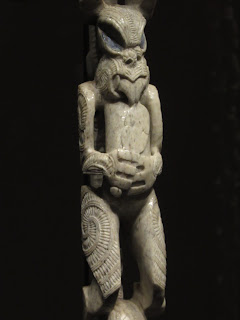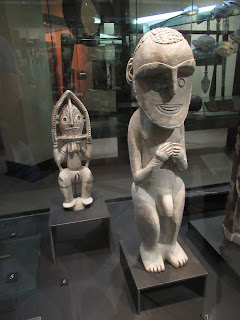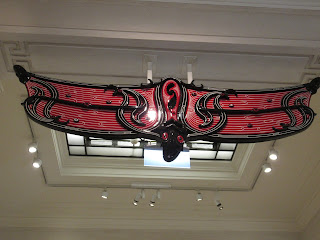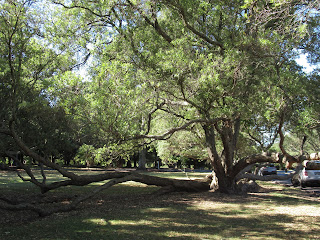You know of the standard joke of women following each other to the bathroom when out together with their spouses or partners? Well, I felt like one of those women on the flight, always making sure I took advantage to use the facilities when my fellow Coloradan seatmates got up to use the bathroom as I had a window seat and didn't want to disturb them!
After more than 24 hours of travel, we finally saw the lovely North Island of New Zealand - what a very welcome sight it was, let me tell you, even though it meant I was further away from my beloved Steven than I 'd ever been since we met in Zihuatenejo, Mexico, back in March of 1981.
For those of you unaware of New Zealand, the country is made up of two main islands, the North Island where we'd be starting out our trip for several days, and the South Island which seems to attract the most oohs and aahs from tourists and where we'd spend a very quick ten days. The country is a long, long ways to go to, even without the extra time we had to endure, that just two weeks trying to see its highlights requires a lot of driving and a lot of drive-by moments. Ideally, the country merits another week minimum but the two weeks was all we had and all the time I wanted to be separated from Steven before also spending some time in and around Melbourne and exploring Tasmania.
Diane and I had booked an Auckland harbor cruise but luckily it got cancelled at the last moment as we'd never have been able to make it in time anyways because of our late arrival at the airport. This way we got our money refunded so that was the good news, bad news situation of missing out on the anticipated cruise in the City of Sails as the city is known.
Instead, we hailed an Uber and headed to the Auckland War Memorial Museum that was built in 1929 to commemorate the end of WW I in which more than 18,000 New Zealanders died. The museum's Neo-Classical design evoked the Greek temples many servicemen viewed from the decks of their warships in the Mediterranean. Diane and I were interested in seeing one of the world's greatest collection of Maori treasures the museum had as well as hoping to gain an introduction to the country's history, people and landscape.
The first half of the 19th century saw the emergence of various distinct regional carving styles. The museum had a massive and extremely impressive collection of carvings from the North Island.
It was interesting learning that across Polynesia there are similar words used for the same thing. All Polynesian languages descend from that spoken by the Lapita people, the Polynesian ancestors who traveled throughout the Pacific 3,000-3,500 years ago. As people migrated across the Pacific, distinct languages developed within each island group. Five groupings of Polynesian languages have been identified, based on the number of words they share with each other. New Zealand Maori is most closely linked to languages in the Society,Tuamotu and Cook Island groups.
This gable mask was the only known carving from Mayor Island in the Bay of Plenty which was an important source of obsidian used by Maori throughout the country. The protruding tongue, we soon realized, was an enduring theme in the Maori culture.
This was a pou or carved wall slab or post that supported rafters which held up the roof. Carvings on pou recorded significant tribal ancestors or stories.
I wouldn't want to run afoul of this man, even though it was but a carving!
A famous carver and others in the Ngati Tarawhai tribe were commissioned to build this pataka or storehouse in the 1870s. It also was intended to symbolize status and power of one of the great Maori leaders and to illustrate his genealogy. Patakas were fixtures in Maori villages.
The front of the striking pataka:
In 2007, after a dozen sperm whales were stranded at a beach, a superb, carved whalebone walking stick was carved for a tribal king as an expression of their values and principles. Each Maori monarch was represented on the four-foot stick - this was only a small part.
The Hotunui was an ancestral meeting house of the Ngati Maru people. In Maori culture, homes like these were representations of ancestors and held in the highest regard. All who entered were asked to remove their shoes and behave in a respectful manner in the home.
We saw no guards around and were so surprised and delighted that we could enter the meeting house and therefore be able to admire it much more closely.
The carvings and the textiles were so richly made and so stunning.
One of the museum's must-sees was the Te Toki a Tapriri, the last of the great Maori war canoes. It was hewn with an adze, a stone-cutting tool used since the Stone Age from just one mammoth totara log. The 85-foot long canoe was built to carry 100 warriors in 1836.
Never do I remember coming across anything remotely that large carved from one piece of any material. The craftsmanship was sheer perfection.
The elaborate carvings on both the bow and stern were also spectacular.
The carved doorway of a pataka marked an important symbolic threshold and the carved figure that presided over the doorway represented a deified creator/ancestor of the tribal chief. Steven - I am sure you also would have recognized the similarity in the moais we saw all over Easter Island in 2017. I kept thinking of how much you would have loved what we were seeing so I hope I can convey some of the beauty of the Maori treasures in this post.
Both Diane and I smiled when we noticed this Maui plush doll, Moana, that was made into a Disney film in 2016! I'd like to see the film now I've seen this creature.
Shields used in wars:
These intricate articles of jewelry from the Solomon Islands included hair ornaments, breast plates and earrings from top to bottom.
In the Pacific, figure sculptures represented mythical heroes, ancestors, gods or personified forces of the natural and supernatural world. Some figures were designed to stand alone and others were part of architectural structures. They weren't idols but rather material representations of the spirit world to enable communication between humanity and the spirit world.
The entrance to the museum we'd used wasn't very interesting so coming across the beautiful lobby and its tall columns reminiscent of the Parthenon in Greece was a special treat.
The stained-glass ceiling above the main foyer depicted the Coat of Arms of all British dominions and colonies during WWI.
After spending well over an hour in the most unusual war museum I'd ever come across, it seemed only appropriate to finally enter The Hall of Memories on the second floor.
It was sad seeing the list of names of those men from Auckland who'd given their lives in wars around the globe for their fellow New Zealanders. Honoring them by reading some of their names for a few minutes names was important.
This pou or carved post named Maumahara stood as the guardian to the Memorial Discovery Center. He symbolized a returned soldier, representing those who came home and as well as those who did not. The pou was carved from Australian blue gum that reflected the wider Pacific allegiances.
Zachary: I specifically made a point of going to the Spitfire Gallery which featured an early fighting plane. New Zealanders filled many roles in the British Royal Air Force during World War II, serving in fighter, bomber and coastal commands in every theater of war.
Just like my fellow Canadians, New Zealanders serve as peacekeepers around the world as Diane and I saw on the map below.
One thing I found especially moving at the museum was seeing this exhibit asking people to share their memories if they'd been prisoners of war.
Since this was after all a war museum, there were many more displays on matters of war as it affected New Zealanders but Diane and I chose to explore more of the museum's cultural exhibits which were topnotch and totally unexpected in a war museum.
The images of the Twelve Caesars were made of ivory, wood and and semi-precious stones. We both thought they were stunning.
Steven: How you'd have loved seeing the 19th century lacquer Buddha and other statues from India in the gallery that had well over a hundred other items from Asia.
Who would have ever dreamt of seeing a Chinese storage jar from the Song Dynasty that occurred from 960-1279 in a war museum in New Zealand? Not I, definitely. It was made of stoneware with a three-color lead glaze.
The accompanying Wine Pots were also from the same period and dynasty.
The museum purchased this pre-1956 torso from Goa, India.
More views of the spectacular lobby:
The museum also had an extensive collection of smallish items from Central and South America.
Both the Dog and Horse Figurines came from the Wei Dynasty that existed from 220-265 BC in China.
Steven and I were lucky to spend some time in Egypt exploring the ancient tombs all over the country but we'd never seen anything like these Painted Portraits done in wood during the Roman Period from 30 BC-395 AD. They had been commissioned by the wealthy citizens of Fayoum as funerary masks for use on their mummies.
Isis, the Egyptian goddess of protection, was shown on both sides of this wooden painted coffin end. The hieroglyphics referred to death and rebirth.
The mummy, coffin and wrappings had to be displayed in a low oxygen and nitrogen-filled and humidity-controlled atmosphere.
The sky goddess Nut from the time of the New Kingdom (1550-1069 BC) was often depicted on the underside of coffin lids over the body of the deceased. That way, the dead person was therefore back inside the mother's body and ready for rebirth and re-enactment of the daily journey of the sun between heaven and earth.
I tried so hard to get a non-fuzzy photo of this Theater Mask done in marble in southern Italy that were often depicted in Roman art but this was the best I could get.
The Cenotaph in front of the museum mirrored those erected in London and elsewhere around the British Commonwealth. Diane and I were both stunned and delighted that Auckland's 'war museum' was far, far more than that. It provided us with a welcome introduction of the country's history and a chance to be treated to the world's greatest collections of Maori treasures.
Let me end our visit by including the words inscribed in the reflecting pool in front of the museum:
In reflection, we find a sense of place, a sense of who we are.
Here, now let us remember those who went before us, whose sacrifices gave us life.
We are the children of the fallen - we stand on their shoulders.
The museum was located in the Auckland Domain, the city's oldest park that had also been the site of one of the city's 14 volcanic cones. The 340-acre park was set aside in 1840, in the early years of European settlement. It is an enormously popular place for cricketers as well as lots of walkers, particularly the "Remuera Bobs," women whose husbands like their wives trim and young looking, according to what I read!
Since it was such a splendid day, Diane and I decided to walk through the park to the hotel since we wanted to enjoy the sun and get out the bugs from being cooped up for so long in the plane!
The park's palm trees were unlike those I remembered seeing anywhere else when traveling overseas with Steven. These ones had no discernible trunk but instead very, very skinny vines that grew upright from the ground.
As we left the park, we noticed tuff rings created by volcanic activity thousands of years ago.
We discovered a fabulous walking trail that enabled us to bypass most car-filled streets on the way back.
I appreciated how some older buildings in Auckland hadn't torn down in the name of progress but instead incorporated into the design of new ones.
You can imagine how totally wiped just two nights ago we were when our heads finally hit the pillows after traveling for more than a day and catching only fitful naps on the plane! That very, very long trip is not something I recommend to anyone who has both time and money to break up the trip to 'down under.' But what an adventure awaits us as I hope you will read about in the ensuing posts about our whirlwind trip to New Zealand and a small part of Australia.
Next post: Driving our rental car up and around the gorgeous Coromandel Peninsula en route to Rotorua.
Posted on March 4th, 2019, from Rotorua on NZ's North Island.



































































































WOW! It's certainly a strange feeling not being with you and reading the post here in Denver. But your pictures and commentary make me feel like I'm right there with you.
ReplyDeleteLove you so much. Be safe.
What an amazing trip, the blog and pics are great! I was taken back with the public restroom as well, thought it was a Church at first :) The beaches, towns and museums all look so wonderful. Glad your having fun together.
ReplyDeleteSafe flight home. Hugs.